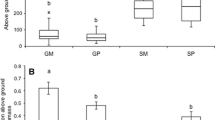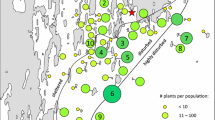Summary
Survivorship and growth of individuals of the annual plant Phlox drummondii were examined in artificial, density-stressed populations composed of five genetically differentiated varieties sown in monocultures and in five pairwise mixtures. All experiments were replicated under two treatments of nutrient availability.
Varieties differed significantly in competitive ability, and relative competitive success was shown to be highly habitat (treatment) dependent. In 19 of 20 mixed populations, the relative rankings of pairs of competitors were consistent with a priori expectations based on the morphological and/or historical differences between seed sources, but were not predictable from relative tolerances to density stress in monoculture.
Estimated selection coefficients based on relative competitive abilities ranged from 0.04 to 0.94. Despite these large fitness differences among competing varieties, most of the variance in the absolute fitness of individuals resided within varieties. This variation may be mostly environmental.
In the high nutrient treatment, where competition for light was most intense, variation in individual plant size was lower in mixed culture as compared to monocultures. Genetic variation for competitive ability may actually lead to greater size uniformity among survivors by promoting an early initiation of thinning, thereby reducing the density stress on survivors.
Similar content being viewed by others
References
Allard RW, Adams J (1969) Population studies in predominantly self-pollinating species. XIII. Intergenotypic competition and population structure in Barley and Wheat. Am Nat 103:621–644
Antonovics J (1978) The population genetics of mixtures. In: Wilson JR (ed) Plant Relations in Pastures. CSIRO, East Melbourne, pp 233–252
Antonovics J, Primack R (1982) Experimental ecological genetics in Plantago. VI. The demography of seedling transplants of P. lanceolata. J Ecol 70:55–75
Bailey RJ, Rees J, Adena MA (1978) Interchange heterozygosity and selection in rye. Heredity 41:1–12
Bazzaz FA, Harper JL (1976) Relationship between plant weight and numbers in mixed populations of Sinapsis alba (L.) Rabenh. and Lepidium sativum L. J Appl Ecol 13:211–216
Bazzaz FA, Levin DA, Schmierbach MR (1982) Differential survival of genetic variants in crowded populations of Phlox. J Appl Ecol 19:891–900
Black JN (1957) The early vegetative growth of three strains of subterranean clover (Trifolium subterraneum L.) in relation to size of seed. Aust J Agric Res 8:1–14
Black JN (1958) Competition between plants of different initial seed sizes in swards of subterranean clover (Trifolium subterraneum L.) with particular reference to leaf area and the light microclimate. Aust J Agric Res 9:299–318
Bradshaw AD (1972) Some of the evolutionary consequences of being a plant. Evol Biol 5:25–43
Burdon JJ, Harper JL (1980) Relative growth rates of individual members of a plant population. J Ecol 68:953–957
Cavers PB, Harper JL (1966) Germination polymorphism in Rumex crispus and R. obtusifolius. J Ecol 54:367–382
Christie BR, Kalton RR (1960) Recurrent selection for seed weight in Bromegrass, Bromus inermis, Leyss. Agron J 52:575–578
Cideciyan MA, Malloch AJC (1982) Effects of seed size on the germination, growth, and competitive ability of Rumex crispus and Rumex obtusiofolius. J Ecol 70:227–232
Cook SCA, Lefebvre C, McNeilly T (1972) Competition between metal tolerant and normal plant populations on normal soil. Evolution 26:366–372
Criswell JG, Shibles RM (1971) Physiological basis for genotypic variation in net photosynthesis of oat leaves. Crop Science 11:550–553
Dewsberry R (1977) Plant self-thinning dynamics. Planta 136:249–252
Draper AD, Wilsie CP (1965) Recurrent selection for seed size in Birdsfoot Trefoil, Lotus corniculatus L. Crop Sci 5:313–315
Eagles HA, Hardacre AK (1979) Genetic variation in maize (Zea mays L.) for germination and emergence at 10 degrees C. Euphytica 28:287–295
Evans LT (1976) Physiological adaptation to performance as crop plants. Phil Trans Royal Soc Lond B 275:71–83
Fehr WR (1973) Evaluation of intergenotypic competition with a paired row technique. Crop Science 13:572–575
Fehr WR, Weber CR (1968) Mass selection by seed size and specific gravity in soybean populations. Crop Science 8:551–554
Gifford RM, Evans LT (1981) Photosynthesis, carbon partitioning and yield. Ann Rev Plant Physiol 32:485–509
Gorham E (1979) Shoot height, weight and standing crop in relation to density of monospecific plant stands. Nature 279:148–150
Gustafsson A (1953) The cooperation of genotypes in Barley. Hereditas 39:1–18
Harper JL (1961) Approaches to the study of plant competition. In: Milthorpe FL (ed) Mechanisms in Biological Competition. Symp Soc Exp Biol 15:1–39
Harper JL (1977) Population Biology of Plants. Academic Press, London
Harper JL, Ogden J (1970) The reproductive strategy of higher plants I. The concept of strategy with special reference to Senecio vulgaris L. J Ecol 58:681–698
Harper JL, Williams JT, Sagar GR (1965) The behavior of seeds in soil. I. The heterogeneity of soil surfaces and its role in determining the establishment of plants from seed. J Ecol 53:273–286
Heichel GH, Musgrove RB (1969) Varietal differences in net photosynthesis of Zea mays L. Crop Science 9:483–486
Hewitt EJ (1966) Sand and Water Culture Methods Used in the Study of Plant Nutrition, 2nd ed. Farnham Royal (Bucks), Commonwealth Agricultural Bureau
Hickman JC (1977) Energy allocation and niche differentiation in four coexisting annual species of Polygonum in western North America. J Ecol 65:317–326
Jennings PR, Aquino RC (1968) Studies on competition in rice. III. The mechanism of competition among phenotypes. Evolution 22:529–542
Jennings PR, Herrera RM (1968) Studies on competition in rice. II. Competition in segregating populations. Evolution 22:332–336
Kelly JP (1935) Cultivated varieties of Phlox drummondii. J New York Bot Gard 16:179–191
Khalifa MA, Qualset CO (1974) Intergenotypic competition between tall and dwarf wheats. I. In mechanical mixtures. Crop Science 14:795–799
Kishitani S, Tsunoda S (1981) Physiological aspects of domestication in diploid wheat. Euphytica 30:247–252
Law R, Bradshaw AD, Putwain PD (1977) Life history variation in Poa annua. Evolution 31:233–246
Leverich WJ, Levin DA (1979) Age-specific survivorship and reproduction in Phlox drummondii. Am Nat 113:881–903
Levin DA (1976) Consequences of long-term artificial selection, inbreeding, and isolation in Phlox. II. The organization of allozyme variability. Evolution 30:463–472
Levin DA (1977) The organization of genetic variability in Phlox Drummondii. Evolution 31:477–494
Levin DA, Wilson JB (1978) The genetic implications of ecological adaptations in plants. In: Freysen and Woldendorf (eds) Structure and Functioning of Plant Populations, pp 75–100
Mack RN, Harper JL (1977) Interference in dune annuals: spacial pattern and neighborhood effects. J Ecol 65:345–363
Morrison DF (1976) Multivariate Statistical Methods. McGraw-Hill, New York
Nelson LR (1980) Recurrent selection for improved rate of germination in annual ryegrass. Crop Science 20:219–221
Orton RB (1969) The climate of Texas. In: Climates of the States, volume 2. NOAA, US Dept Commerce, Washington DC, pp 877–920
Puckridge DW, Donald CM (1967) Competition among wheat plants sown at a wide range of densities. Aust J Agric Res 18:193–211
Ross MA, Harper JL (1972) Occupation of biological space during seedling establishment. J Ecol 60:77–88
Sakai KI (1955) Competition in plants and its relation to selection. Cold Spr Harb Symp Quant Biol 20:137
Sheldon JC (1974) The behavior of seeds in soil. III. The influence of seed morphology and the behavior of seedlings on the establishment of plants from surface-lying seeds. J Ecol 62:47–66
Solbrig OT (1981) Studies on the population biology of the genus Viola. II. The effect of plant size on fitness in Viola sororia. Evolution 35:1080–1093
Solbrig OT, Simpson BB (1974) Components of regulation of a population of dandelions in Michigan. J Ecol 62:473–486
Solbrig OT, Simpson BB (1977) A garden experiment on competition between biotypes of the common dandelion (Taraxacum officinale). J Ecol 65:427–430
Sterk AA (1969) Biosystematic studies of Spergularia media and S. marina in the Netherlands. Part 1. The morphological variability of S. media. Acta Bot Neerl 18:325–338
Suneson CA (1949) Survival of four barley varieties in a mixture. Agron J 41:459–461
Voight PW, Brown HW (1969) Phenotypic recurrent selection for seedling vigor in side-oats grama, Bouteloua curtipendula. Crop Science 9:664–666
Watkinson AR, Lonsdale WM, Firbank LG (1983) A neighborhood approach to self-thinning. Oecologia (Berlin) 56:381–384
White J (1980) Demographic factors in populations of plants. In: Solbrig OT (ed) Demorgraphy and Evolution of Plant Populations. University of California Press, Berkeley, pp 21–48
White J (1981) The allometric interpretation of the self-thinning rule. J Theor Biol 89:475–500
Zangerl AR, Bazzaz FA (1983) Plasticity and genotypic variation in photosynthetic behavior of an early and a late successional species of Polygonum. Oecologia (Berlin) 57:270–273
Author information
Authors and Affiliations
Rights and permissions
About this article
Cite this article
Heywood, J.S., Levin, D.A. Genotype-environment interactions in determining fitness in dense, artificial populations of Phlox drummondii . Oecologia 61, 363–371 (1984). https://doi.org/10.1007/BF00379636
Received:
Issue Date:
DOI: https://doi.org/10.1007/BF00379636




